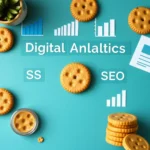Cookie-free marketing: Content, inbound & MrBeast
Understanding the cookieless future

The demise of third-party cookies
The digital landscape is evolving rapidly, particularly with the decline of third-party cookies. Advertisers have relied on these cookies to track user behavior and serve targeted ads. Unfortunately, as privacy concerns rise, browsers are implementing policies to block third-party trackers, significantly impacting digital advertising strategies. Marketers are now challenged to rethink their approaches, shifting towards more ethical methods that respect consumer privacy while still delivering effective advertising.
As regulations around data privacy become stricter, brands are increasingly required to obtain consent from users before collecting any personal data. Laws such as the GDPR and CCPA have set the standard for user privacy, causing brands to adapt quickly or face potential penalties. Consequently, establishing transparent consent processes will be paramount for marketers to build trust with their audience. Brands that prioritize ethical marketing and privacy compliance will likely find favor with consumers in this transforming landscape.
The rise of first-party data
With the decline of third-party cookies, the focus has dramatically switched to first-party data collection. This data, collected directly from customers, can unlock powerful marketing insights and foster deeper relationships. By leveraging first-party data, businesses can personalize their marketing strategies, catering specifically to user preferences and behaviors. Engaging customers in meaningful ways can build loyalty, resulting in long-term relationships that drive repeat business.
To effectively gather first-party data, marketers should implement several strategic approaches. Creating compelling lead magnets, such as free resources or exclusive content, can encourage users to share their information willingly. Additionally, utilizing surveys and feedback forms can provide valuable insights into customer preferences while reinforcing the brand’s commitment to user engagement. As businesses prioritize transparent communication and value, customers will feel more inclined to share their data.
Content marketing in a cookie-free world

Creating high-quality, engaging content
In a world without cookies, content marketing emerges as a crucial pillar for connecting with audiences. Marketers must focus on creating high-quality and engaging content that addresses user intent and needs. By researching relevant topics and understanding customer pain points, brands can provide value-driven content that resonates with their audience. Establishing authority and trust through consistent, valuable content will be essential in landing and retaining customer interest.
Optimizing content for search engines is vital in the cookieless landscape. With fewer tracking tools available, businesses must rely on organic search traffic and SEO best practices to drive visibility. This includes conducting thorough keyword research, implementing effective on-page SEO strategies, and fostering high-quality backlinks. By optimizing their content to align with user search behaviors, brands can increase their chances of appearing in search results without the need for cookies.
Building a loyal audience through content
It’s not enough to create great content; marketers must also focus on effective distribution strategies to reach their target audience. Utilizing various channels—such as social media platforms, email newsletters, and collaborations—can amplify the reach and impact of the content. Additionally, leveraging content partnerships can introduce the brand to new audiences and create networking opportunities. Engaging with audiences across multiple platforms increases visibility and reinforces brand loyalty.
Measuring the performance of content is essential for long-term success. Analyzing engagement metrics, such as clicks, shares, and comments, can provide valuable insights into what resonates with the audience. Tools like Google Analytics can track traffic sources, user behavior, and conversion rates. By continuously assessing content performance, marketers can refine their strategies, ensuring they are meeting audience needs effectively and producing desired outcomes.
Inbound marketing strategies for a cookieless future

Attracting and converting leads without cookies
Personalized email marketing will play a crucial role in attracting and converting leads without relying on third-party cookies. Utilizing first-party data collected through sign-ups and user interactions, marketers can create tailored email campaigns that resonate with individual preferences. Segmentation is key; by tailoring messages based on customer behavior, brands can increase open rates and engagement significantly. Additionally, providing relevant content and offers encourages conversions while building brand loyalty.
Social media platforms offer powerful opportunities for lead generation and engagement in a cookieless world. Businesses can utilize targeted ads based on first-party data to reach specific audience segments effectively. Moreover, social media enables direct interaction with customers, which can foster community and brand affinity. Incorporating user-generated content and encouraging audience participation can create an authentic brand experience that attracts and retains customers.
Nurturing leads and building relationships
Marketing automation tools combined with Customer Relationship Management (CRM) systems can streamline lead nurturing processes. By automating marketing tasks such as follow-up emails and personalized content delivery, brands can effectively engage with leads over time. This consistency in communication is crucial for building trust and keeping prospects informed about the brand. Integrated systems allow for seamless data management, ensuring that marketers are targeting users based on up-to-date information.
Lead scoring is an essential part of nurturing campaigns, particularly in a cookie-free environment. By assigning scores to leads based on their interaction with content, brands can prioritize leads that show higher engagement potential. Segmentation allows marketers to deliver more targeted content to different subsets of their audience, significantly improving relevance and engagement. Effective lead nurturing will ultimately guide prospects along the sales funnel towards conversion.
Learning from MrBeast: unconventional marketing tactics

Understanding MrBeast’s audience engagement
MrBeast has taken the internet by storm with his unconventional marketing tactics, focusing on creating unforgettable experiences for his audience. By producing viral content that resonates widely, he has built a loyal following that eagerly anticipates his next project. The key to his success lies in understanding what engages audiences creatively; by tapping into emotions and delivering pure entertainment, MrBeast has carved out a unique niche. Brands can learn valuable lessons about storytelling and building memorable experiences from his approach.
Community has been a cornerstone of MrBeast’s success—he actively engages with his followers and incorporates their feedback into his content. Creating a sense of belonging encourages audiences to become advocates for the brand. Fostering community-driven initiatives can help brands attract dedicated followers who contribute to meaningful conversations. In a cookie-free world, building genuine connections ensures that brands remain relevant to their audiences.
Applying MrBeast’s principles to your marketing
MrBeast’s marketing approach revolves around delivering immense value and entertainment, a principle that all brands should adopt. By focusing on creating content that genuinely interests and entertains the audience, businesses can increase engagement and build rapport. Whether it’s through humorous videos or insightful guides, brands must prioritize value creation. By delivering unique experiences that stand out, they can foster loyalty and encourage sharing among consumers.
Influencer marketing is a powerful strategy that can help brands reach wider audiences in a cookieless landscape. Collaborating with influencers like MrBeast can amplify messaging and engage new customers. Brands should seek partnerships that align with their values to maintain authenticity. By leveraging the popularity of trusted figures, brands can tap into existing communities, effectively broadening their reach without relying on traditional cookie-based tracking technologies.
Preparing your business for the cookieless future

Assessing your current marketing strategies
To navigate the cookieless future effectively, businesses must first assess their current marketing strategies. By identifying areas for improvement, such as reliance on third-party data collection, companies can proactively evolve their tactics. Conducting a thorough audit of marketing channels can reveal opportunities to enhance user engagement and better tailor experiences to customer needs. Addressing weaknesses now will position brands for success in an increasingly privacy-focused market.
Creating a roadmap for a cookie-free future involves planning actionable steps that shift marketing efforts toward data compliance and user engagement. This may include investing in better first-party data collection methods and refining content strategies for organic search visibility. Engaging stakeholders across different departments ensures alignment and comprehensive insights that drive the marketing mission forward. A well-defined roadmap will empower brands to navigate transitions seamlessly while staying ahead of the competition.
Investing in the right technologies and tools
As the landscape shifts, investing in modern technologies becomes a necessity. Data Management Platforms (DMPs) can aid in collecting, analyzing, and activating first-party data effectively. These systems help marketers segment their audience better and deliver personalized experiences without compromising privacy. Employing DMPs enables more robust marketing strategies that align with consumer expectations, allowing brands to maintain relevance in a changing environment.
Customer Data Platforms (CDPs) offer another layer of support, unifying customer data from multiple sources into a single view. This consolidation allows brands to create richer user profiles, leading to improved targeting and personalization. By effectively leveraging CDPs, businesses can make informed decisions based on comprehensive insights about their customers. This investment not only enhances marketing efficiency but also builds a more customer-centric approach that resonates long after cookies are gone.













